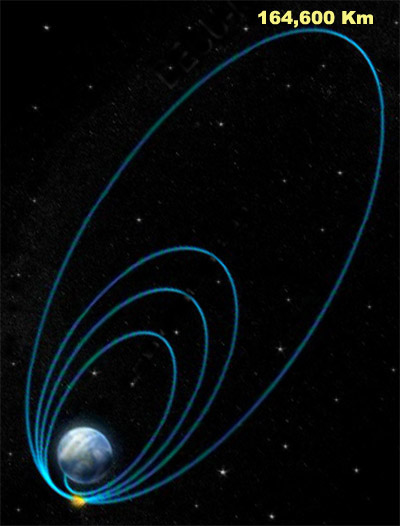After a successful maneuver early today (October 26, 2008), the Chandrayaan-1 spacecraft has crossed the 150,000 km distance mark from Earth, officially entering
deep space
, on course for the moon. This was the third orbit raising maneuver of the mission. The spacecraft's 440 Newton liquid engine was fired for about nine and a half minutes, beginning at 07:08 IST. With this, Chandrayaan-1 entered a much higher elliptical orbit around the Earth. The apogee (farthest point from Earth) of this orbit lies at 164,600 km while the perigee (nearest point from Earth) is at 348 km. In this orbit, Chandrayaan-1 takes about 73 hours to go round the Earth once.
To compare, Chandrayaan's initial orbit had a perigee of 255 km and an apogee of 22,860 km, with about a 6.5-hour period. After the second boost from its engines, Chandrayaan raised its apogee to 37,900 kilometers, and increased its orbit period to 11 hours.
Engineers from the Jet Propulsion Laboratory are also providing backup navigation assistance to the Indian Space Agency in Bangalore, India, by helping to track the flight dynamics. The antennas of the Indian Deep Space Network at Byalalu are being used for tracking and communicating with Chandrayaan-1 spacecraft in its high orbit. From the image below, you can see how additional orbit raising maneuvers in the next few days will take Chandrayaan-1 towards the Moon, and then into lunar orbit. Currently, the spacecraft is scheduled to reach lunar orbit on November 8. [caption id="attachment_20112" align="alignnone" width="580" caption="Chandrayaan mission profile. Credit: ISRO"]
[/caption]
Source: ISRO
 Universe Today
Universe Today
